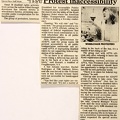San Antonio Light, April 21, 1985 Viewpoint
Thomas F. Brereton
[Headline] Give handicapped the transit they deserve
PHOTO: Head shot of a man in suit and tie, with a beard and moustach. He is smiling, and he appears to be Brereton.
San Antonio's convention calendar features an unwanted bonus this weekend: some out of town demonstrators who have vowed to disrupt a conference at the Hyatt, in order to focus attention on a neglected national issue. The American Disabled for Accessible Public Transit (ADAPT) are the unwelcome guests at the American Public Transit Association's western regional conference. They have been similarly unwelcome guests at APTA conferences in Denver, San Diego, and Washington, D.C., where 28 members were arrested for civil disobedience last October. So now San Antonio's VIA Metropolitan Transit gets to take its turn playing cat's paw to make their point.
ADAPT's demand is a simple one: civil rights for the handicapped, specifically the right to ride the same bus as everyone else. This means requiring public transit systems to make all of their mainline services fully accessible, particularly by installing wheelchair lifts instead of relying exclusively on separate “para-transit” services like VIA-Trans. They contend that this dual service system is a segregationist anachronism: 25 years ago blacks could at least ride in the back of the bus: today the handicapped still can't even get on board.
At first blush, it may seem hard to believe that a person who is wheelchair-bound would really prefer to struggle to and from the bus stop in order to ride a regular bus, rather than being picked up and delivered door-to-door in a specially equipped van. But there are some real problems with a van service which makes it inherently less usable than full access to the regular transit network.
First there is the matter of registration. In order to ride VIA-Trans, you have to be certified by a physician or a social service agency as completely unable to use the regular bus. As a result, there are only about 7000 people registered in Bexar County. Estimates of the potentially eligible “mobility-impaired" population range from 12,000 to 52,000, depending on whose definition you accept. Out of town visitors, of course, have a special difficulty of making arrangements in advance.
Then there is the matter of time. You have to call and make a reservation at least two hours ahead, and preferably a couple of days. This may be okay if you know you have a doctors appointment every Wednesday at 2 o'clock. but it is no way to go out drinking with your friends on the spur of the moment. And since this is a shared-ride system, you will probably have to leave a lot earlier than you would like, and then to endure a long, circuitous journey to your destination, while other passengers are picked up and dropped off en route.
So imagine yourself now in a wheelchair. Which would you
rather do: Wheel yourself down to the nearest bus stop to get on a bus and go whereever it takes you, or call VIA-Trans a couple of days in advance to make a reservation? You don't have to buy ADAPT's tactics in order to see their point. Handicapped people naturally want to be as independent as possible, with a minimum of degrading “special privileges."
On the other side, transit authority spokesmen ridicule the demand for wheelchair lifts as economically prohibitive and
technically impractical. A study by the National Research Council's Transportation Research Board estimates the total additional cost of operating a fully accessible fixed-route bus system at about $2,000 per year per lift-equipped bus. But unlike VIA-Trans, where more riders automatically mean more vans and drivers - at an average actual cost of $l0.70 per trip — this cost does not increase appreciably with greater use by the handicapped.
Opponents of accessible transit also object that the wheelchair
lifts break down too often. And, you would have to take some regular seats out of the bus, to provide space to secure the wheelchairs. And the requirements of operating the lift would throw the bus off schedule, because the driver would have to take extra time to assist the passenger. In reality, the actual number of times per day you would have to stop the bus to use this lift makes nonsense of this argument.
But what about the problem of getting to and from the bus stop,
along streets without curb cuts and often without sidewalks? This objection is an excuse for not solving one problem because there are other problems beyond it. If you were in a wheelchair, you would probably need to live in a different house, too. You would consider this a factor before you moved.
Note that this is not an either/or proposition, between specialized vans and lift-equipped buses. The same study by the Transportation Research Board estimates that only 30 percent of the "severely transportation handicapped" could use an accessible fixed-route bus. The other 70 percent — those on medication, with mental impairments or multiple handicaps — would still need to rely on VIA-Trans, taxicabs, or other means to get around.
To me. this whole argument is pretty one-sided. The real clincher is the simple fact that other cities have already done what VIA says is impossible: to provide full accessibility on their mainline services.
The old excuses won't wash anymore. it's time we stopped putting a price tag on people's dignity and independence.
Tom Brereton is a former professor of urban studies at Trinity
University.
- Created on
- Thursday 11 July 2013
- Posted on
- Thursday 10 December 2015
- Tags
- 1 week advance reservation, 100% lift equipped, ADAPT - American Disabled for Accessible Public Transit, advance reservation, APTA - American Public Transit Association, cost, demonstrators, maintenance, op-ed, paratransit, wheelchair bound, wheelchair lifts
- Visits
- 2346
- Rating score
- no rate
- Rate this photo


0 comments